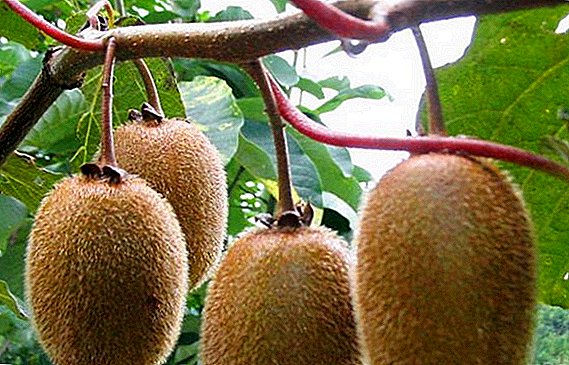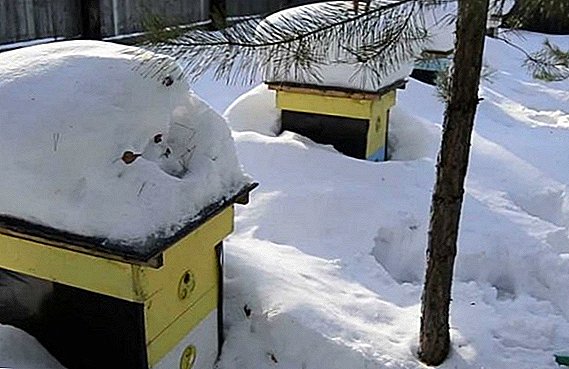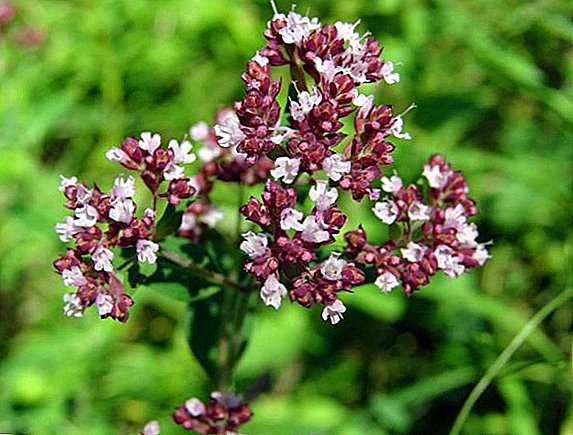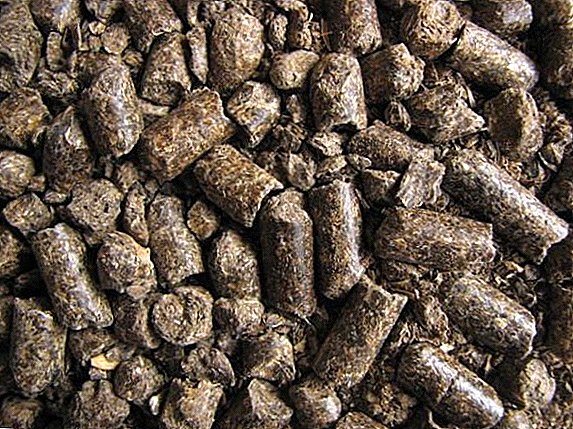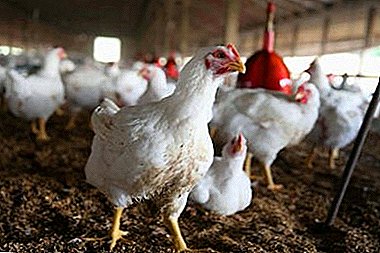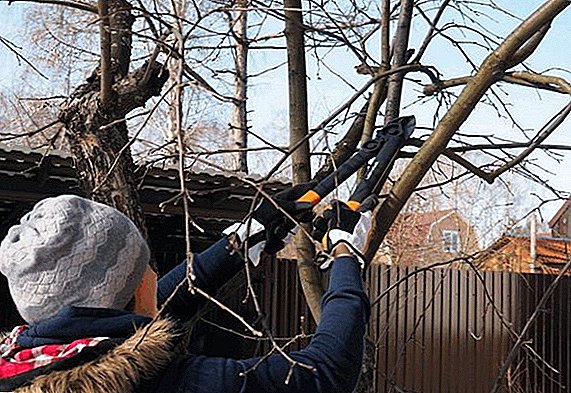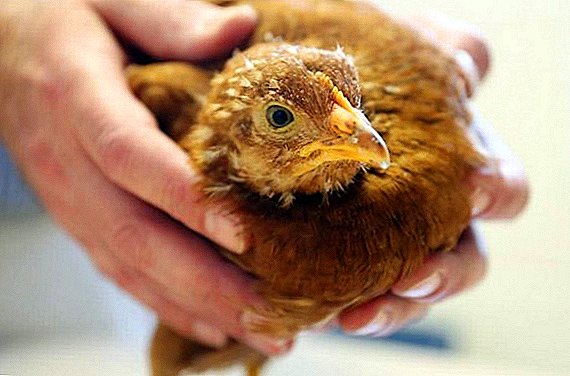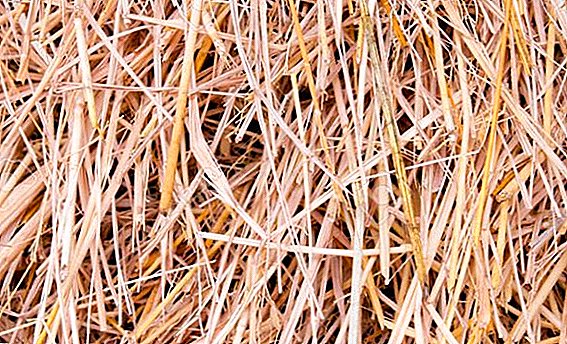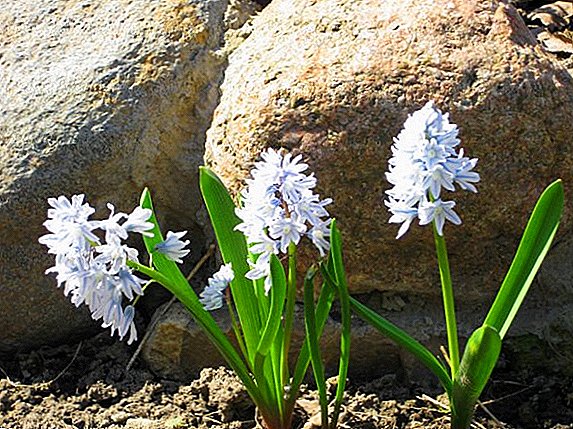 Plants that bloom in early spring have their own unique charm, because by this time we were all yearning for the wild colors of nature, and primroses gladden us at a time when we still have to wait for warm sunny days. Pushkin is the very plant. In this article we will tell you how to plant and care for this beautiful primrose.
Plants that bloom in early spring have their own unique charm, because by this time we were all yearning for the wild colors of nature, and primroses gladden us at a time when we still have to wait for warm sunny days. Pushkin is the very plant. In this article we will tell you how to plant and care for this beautiful primrose.
Botanical description
Pushkinia is popularly called the "dwarf hyacinth", in its structure it is very similar to the scilla. Belongs to onion plants, has a small size. Linear-belt-like dark green color leaves collected in the rosette. From it, an arrow grows upward, on which white-blue or white flowers form, resembling a bell in their form. Flowering occurs in April or May and lasts about three weeks. Flowers have a slightly noticeable, but very pleasant aroma. In height Pushkinia can reach from 10 to 15 cm.
In addition to Pushkinia, onion flowers also include: sparaxis, colchicum, Russian hazel grouse, black tulips, gladioli, triteleya, tigridia, lily cardiocrinum, Babian flower, zephyranthes (upstart flowers) and Ixia.

Distribution and habitat
The main area of natural distribution of Pushkin is Northern Iran, the Transcaucasus, and also the central part of the Northern Caucasus (Elbrus region, Kavminvody). Dwells on grassy slopes, on forest edges and in thickets, up to 1,200 m above sea level.
Did you know? Pushkinia got its name from the famous natural scientist A.A. Musina-Pushkin, who first discovered these flowers, while on the Caucasus mountains.

Popular varieties of Pushkinia
In addition to the fact that Pushkin is loved to be planted in areas for its early flowering, this plant is also successfully used in flowerbeds as a decorative flower. It looks great in many compositions, and caring for it does not require much trouble from the gardener. Rod Pushkin includes only 2 species:
- hyacinth - the flowers of its pale blue color, almost white, with streaks of a brighter shade;

- prolescula (lebanese or lybanotic) - its flowers are larger, with bicuspid lobes of the crown, have a more pronounced blue hue.

Use in landscape design
Gentle and graceful flowers of Pushkinia found wide application in landscape design. It is used in the design of flower gardens, borders, stony gardens, along with other early flowering plants such as Scyllae, crocuses and snowdrops. Due to the fact that our beauty has a short growing season, it is planted next to perennials. The proximity of these plants has many advantages:
- the seat is saved;
- you will always have greenery at the site, starting from the snowfall until mid-autumn;
- The bulbs of the plant in the summer heat will protect the bushes of perennial plants.

Growing at home
Pushkinia is unpretentious and enduring, but for successful planting and further growth it is necessary to take into account certain points, and which ones you will now find out.
Conditions of detention
Choose a landing site at a slight elevation, where there is a lot of sunlight or a light shade. For this fit and places under the trees, because at the time of the flowering stage the trees will not have foliage.
Important! Keep in mind that Pushkinia does not tolerate when groundwater is located nearby. If you do not take into account this moment, it will not affect the plant very well, and in neglected cases, Pushkinia will completely die.

Soil and fertilizer
The composition of the soil is not so significant for our primrose, but an important factor is its fertility, permeability and the presence of drainage. Stagnation of water and overmoistening plants should not be allowed. Before you plan to plant a primrose on the plot, it is necessary to apply such fertilizers to the soil:
- humus, manure or compost in the amount of 5-7 kg per 1 sq. km. m;
- ammonium nitrate - 40-60 g per 1 square. m;
- potassium chloride - 30-50 g per 1 square. m;
- superphosphate - 50-70 g per 1 square. m

To enrich the soil and nourish the plants, use organic fertilizers: straw, pigeon droppings, Florex granulated chicken droppings, bone meal, fish meal, whey, potato peel, compost, eggshell, banana peel fertilizer and tobacco dust.
Watering and moisture
Regular watering is a guarantee of good growth and flowering of Pushkinia. But here it is important not to overdo it. If the weather is dry, the plant should be watered more often, and if there is enough rain, watering should be done as needed. In general, watering should be moderate and regular. After flowering is over, wilted flowers are removed, and the need for watering completely disappears.
Breeding
Our wonderful primrose reproduces in two ways: by seeds and vegetatively. Consider each method of reproduction in more detail. 
Seeds
Seeds are sown on the site immediately after they ripen, usually this period falls on the middle of September-the end of October. Seeds are planted in the soil to a depth of 5-6 cm, after making a mulching with peat. In winter, the seeds undergo natural stratification and subsequently grow much better. Pushkinia can multiply and self-seeding, especially if it grows in a place with a mild climate. Keep in mind that if you choose the seed method of reproduction, flowering will have to wait about 3-4 years.
Vegetative
A simpler and faster way to reproduce our primrose is with the help of bulbs. They are dug up when they fully ripen. The condition of the leaves will help determine this moment - by this time they are already completely dead. If you dig them up earlier, they will be poorly stored. Before being sent for storage, the dug onions must be dried in the shade, shaken off the ground and then cleaned of excess debris and roots.  Pushkin bulbs
Pushkin bulbs
Important! Do not keep the bulbs dug without protection for a long time, because they have a very thin shell, when dried, planting material will be unsuitable for planting.For safe storage of bulbs, wet sawdust or peat will do. Before planting, the bulbs are sorted and sorted according to size. Bad samples are removed. Plant bulbs in the soil should be at a depth of 5-7 cm, keeping a gap of 10-12 cm between them. If you have a lot of small onions, then it is better to send them to grow into a separate bed or apply them in a carpet planting over a large area. The plant will flourish only 1-2 years later.
Relation to temperature
Winter is not very scary for our primrose, especially if there is a lot of snow. But if it is absent, the plant will not be completely comfortable. Therefore, it is best to prepare for the winter. For these purposes, it is possible to carry out soil mulching with humus or dry peat, and if a simpler version is needed, then simply cover the plant with any nonwoven material.
Soil mulching is the way to a rich harvest. Learn why you need soil mulching, especially the application of agrotechnical reception.

Possible difficulties in growing
When growing Pushkinia it must be borne in mind that it is quickly clogged with weeds, so they need to be removed not only before planting, but also during its further growth and development. If you see that the leaves have become brown at the ends, it means that the plant has too much bright light. In this case, a little shading is required. If there are bulging yellow spots on the leaves, this means that the plant has struck rust. Unfortunately, nothing will help with such a problem and will have to completely destroy the plant.
For the future, it also doesn’t hurt you to know that after 5-6 years, the plant needs to be replanted, since the bulbs during this time will grow strongly and begin to interfere with each other. For the same reason, the buds will become much smaller. Otherwise, in fulfilling all the above recommendations, growing Pushkin should not pose any particular difficulties. 
Pests, diseases and prevention
Our primrose is susceptible to all those diseases and pests to which all other small-bulb cultures are also susceptible. First of all, she faces such a dangerous disease, like gray mold, forming brown spots on the leaves. The fungus that causes this disease is very dangerous and quickly spreads to neighboring plants. Therefore, when you find the first signs of the disease, you must immediately apply for treatment Bordeaux liquid or drugs "Topaz", "Champion". In more advanced cases, treatment is carried out with "Fundazol" or "Short".
Did you know? During a disease, a plant behaves like a living organism: its temperature rises, and all processes occurring inside the plant accelerate their pace.Pushkinia bulbs are prone to diseases such as achelenchoides and bulbous rot. The first of these leads to browning the bulb onions, and rot forms in the form of rings. In this case, the plant weakens, there is a violation of the process of its growth.
 Bulb rot
Bulb rotThe only way to get rid of this ailment is prevention. All infected bulbs are destroyed, and healthy before landing on the site soaked in hot water (+ 43-45 ° C). When the bulbs are exposed to bulbous rot, the bases of the leaves turn yellow, and on the bulbs themselves appear patches of red-brown hue. It is possible to get rid of this disease with the help of treatment with copper-containing preparations.
Important! Be careful and keep in mind that bulb rot is often kept in the ground.To avoid the occurrence of the above diseases, it is necessary to properly care for the plant. When watering water should not fall on the leaves, you should not also get involved in fertilizers containing nitrogen.
 Copper preparation
Copper preparationThe main pest of our primrose is the root meadow tick. He eats plant bulbs, which further leads to the process of their rotting or drying. To prevent ticks from appearing on the plot, the bulbs or the soil should be treated with insecticides before planting.
To destroy parasitic insects, use insecticides: "Fastak", "Kinmiks", "Calypso", "Decis", "Marshal", "Vertimek", "Aktara", "Omayt", "Angio" and "Alatar".The bulbs of our plant can also attract mice, so it will not be superfluous to decompose on the bait site or make traps.
On this, our article about the amazing early flowering Pushkinia came to an end. We hope that soon it will delight you on the site with its pale blue bloom, and its delicate aroma will remind you of the approach of this colorful and sunny spring.
If you want your flowers to be beautiful and healthy, learn how to deal with rodents and how to make a mousetrap with your own hands.


